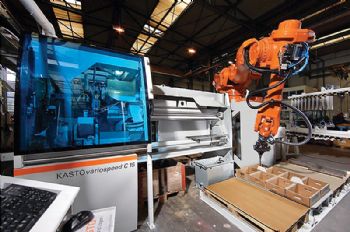
Volker Bühler, group manager for robotics at the German sawing machine and storage system manufacturer Kasto, says that the widening choice of automation systems on offer can minimise labour costs and increase output from the company’s circular saws and bandsaws.
He says that industrial robots make production more flexible and efficient, from batch sizes of one to large volumes. “They also
improve working conditions for operators — and they can significantly reduce costs in stockholding and manufacturing operations.
“More and more, operators of sawing systems are automating them with robots, because they are fast, reliable and precise — and can work 24hr a day without human intervention, if necessary.
“Robotic systems are taking over numerous process steps following sawing, starting with removal of the cut pieces, continuing through deburring, chamfering, measuring and marking — then on to weighing, sorting and stacking on pallets or in containers.
“Moreover, the parts can be transferred to a driverless transport system and taken elsewhere in a warehouse or factory.”
Automation starts with material feeding. For example, the stock to be cut can be supplied to a machine by means of a roller conveyor or a magazine.
Mr Bühler says: “Depending on how a sawing machine is equipped, it can run unattended, with the control system holding all the parameters of a job — including material diameter, band speed, rate of down-feed, cut length and number of parts.
“In complex processes involving numerous work steps, we use combinations of different robots, grippers and other end effectors.
“When large quantities of material with only a few different component geometries are sawn, it is relatively easy to automate the downstream processes.
“However, the situation is different when ‘custom sawing’ involves diverse materials and dimensions. The greater the variety, the more difficult it is to cover all the possibilities.”
‘Tool’ selection
Mr Bühler says end-of-arm tool selection is an important factor. “A robot must be able to deal with all the objects it encounters, while using as few attachments as possible.
“This reduces procurement costs, minimises idle times and increases productivity. Users have a choice of mechanical, magnetic or vacuum grippers — and these should be as compact as possible, to give the robot easy access to the cut parts.
“With the help of the right components, sawing can be combined with other automated operations to create complex highly integrated systems that are seamlessly connected by continuous material flow and include upstream storage as well as downstream handling.”
He says that Kasto, which has a UK subsidiary in Milton Keynes (
www.kasto.com), can implement combined storage and sawing systems in which all processes are automated, from storage of the raw material to retrieval of the cut parts.
“The control software can be linked to existing ERP systems for greater transparency and efficiency.
“Moreover, sawing can even be integrated with other processes such as turning or milling — all within a digitised Industry 4.0 production environment.
“With automated sawing technology, companies can react more easily to order peaks and dramatically reduce idle times.
“We have calculated that, depending on the company’s shift pattern, investing in an industrial robot and a Kasto Variospeed circular saw can pay for itself in less than a year.
“When you consider that such systems are used for more than 10 years on average, users can reduce their operating costs over a significant period of time.
“Moreover, robot technology also helps to improve working conditions, by relieving employees of heavy, tiring and monotonous tasks — and the risk of accidents and injuries is reduced.
“In addition, the cut parts are of better quality, because robots process them with equal precision, sort them reliably and stack them neatly.
“The latter is particularly beneficial, if subsequent operations on the parts are automated.”